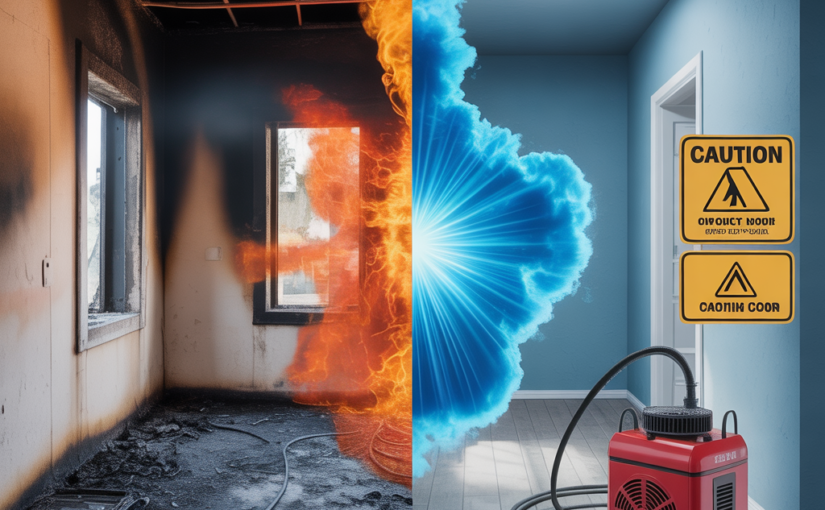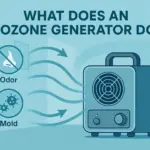Yes, ozone can help eliminate lingering fire or smoke odors by breaking down odor-causing molecules—but it won’t remove soot, stains, or restore damaged materials. Use it only in unoccupied areas and always as part of a broader cleanup effort.
Table of Contents
Why Smoke Odors Are So Hard to Get Rid Of
Anyone who’s dealt with fire or smoke damage knows that the smell doesn’t just linger—it clings. That acrid scent seeps into drywall, upholstery, vents, carpets, and even electrical components. It’s not just a surface problem; smoke embeds itself in porous materials and air ducts, making it incredibly difficult to treat with air fresheners or simple cleaning products.
Smoke particles are tiny and oily, which makes them stubborn. They’re designed to float—and they do, into every crack and crevice.
This is where ozone generators come in. They don’t just mask the odor. They actually break down the odor molecules using oxidation, a chemical reaction that destroys them at the molecular level.
 Can an Ozone Generator Really Help with Fire or Smoke Damage?
Can an Ozone Generator Really Help with Fire or Smoke Damage?
Ozone works best for eliminating smoke odor, not cleaning up the damage. That’s an important distinction. If you’re hoping to remove scorch marks, soot, or yellowing on the walls, ozone won’t help with that. But if you’re weeks or even months post-cleanup and your house still smells like a campfire—or worse—it may be time for an ozone treatment.
Many people have turned to ozone after professional cleaning services still left behind a smoky smell. Used correctly, ozone is extremely effective for this specific purpose.
How to Use an Ozone Generator After a Fire: Step-by-Step
⚠️ Important: Ozone is dangerous to breathe. No people, pets, or plants should be inside the space while the machine is running.
- Clean First: Remove all soot, ash, and debris. Wipe down walls, furniture, and vents. Ozone is not a substitute for cleaning—only a final step to deodorize.
- Ventilate, Then Seal: Air out the space initially, then seal it tight. Close windows, doors, vents, and block return air paths to prevent ozone from escaping.
- Place the Generator High: Smoke rises, and so do lingering odors. Put the ozone machine on a table or shelf for even distribution.
- Set a Timer: For a small room (under 500 sq ft), 1–2 hours may be enough. For larger or more severe cases, 4–8 hours may be needed. Always refer to your device’s manual or this ozone sizing guide.
- Leave the Area: No entry during the cycle. Place warning signs on doors: “Do Not Enter – Ozone Treatment in Progress.”
- Air It Out: Once the cycle ends, wait at least 1 hour before opening doors and windows. Let the room ventilate for 2–4 hours before re-entry.
Real-Life Example: When Ozone Saved the Day
After a minor kitchen fire, Dan and Lisa had their apartment professionally cleaned, repainted, and the HVAC filters replaced. Still, a bitter smoky smell clung to the unit. Friends recommended they try an ozone treatment. They sealed the space, set up a mid-sized machine overnight, and left for the weekend.
When they returned, the difference was incredible. No more smoke smell in the curtains, furniture, or even the fridge (which had absorbed some odor too). It was like breathing in fresh air for the first time in weeks.
Ozone vs. Other Smoke Odor Solutions
People often try a lot of things before turning to ozone:
- Vinegar: Good for light odors, but won’t touch embedded smoke in walls or furniture.
- Activated Charcoal: Useful as a passive filter, but too slow for severe odors.
- Air Purifiers: HEPA filters trap particles, but don’t remove existing smells.
- Enzyme Sprays: Sometimes work on fabrics but don’t treat the whole room effectively.
Only ozone fills the entire space, including hard-to-reach areas like vents and insulation gaps.
When You Shouldn’t Use Ozone
If your home has not yet been cleaned or you still see visible smoke or soot damage, ozone should not be your first step. Also, if anyone in your home has respiratory issues or chemical sensitivities, it’s crucial to allow extra ventilation time and avoid repeat treatments.
Always treat ozone as a follow-up to professional or DIY fire cleanup—not a replacement for it.
DIY vs. Professional: Should You Try This Yourself?
For light smoke damage or one-room issues, DIY is totally doable with a quality ozone machine and proper safety prep. But for whole-home smoke remediation after a fire, you may want to bring in a restoration professional who knows how to balance ozone use with thermal fogging, HVAC duct cleaning, and material replacement.
You can also read more about general ozoning do’s and don’ts here.
What If Ozone Doesn’t Work?
Sometimes the smoke has been absorbed too deeply—into carpet padding, drywall, or ductwork. In those cases, you might need to replace materials or use ozone in combination with a UV HVAC system that can keep odors from returning.
As a backup plan, consider a whole-house HEPA system or even enzymatic cleaners for spot odor treatment.
Where to Learn More
We have an entire article explaining how ozone generators work, including pros, cons, and safety tips. Be sure to read that if you’re considering ozone for the first time.
For more help choosing the right size machine, check out our Ozone Generator Sizing Guide.
FAQ: Fire and Smoke Odor Removal with Ozone
Can ozone remove smoke smell from furniture?
Yes, but it depends on the material. Ozone can penetrate fabrics and foam to some degree. For deeply soaked items, multiple treatments may be necessary.
Is ozone safe to use after a fire?
Yes, as long as it’s used properly—only in unoccupied spaces, after visible damage is cleaned, and with proper ventilation afterward.
How long does it take to get rid of smoke smell with ozone?
Most rooms need 1–8 hours of treatment depending on size and severity, followed by several hours of ventilation. For whole homes, overnight or multi-day cycles may be used.
Can I sleep in the room the same day I run the ozone machine?
Only if it’s been fully aired out. Wait at least 4–6 hours after treatment before re-entering and ensure there’s no residual smell or irritation.





